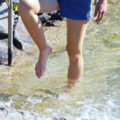Summer, sun and holidays

Tick warnings all over Europe
For the last few weeks, half of Europe has been on the move. Many people are drawn to nature: popular activities include mountain hiking tours and trips to the sea to go swimming. Some people also enjoy their leisure time in their own gardens. But wherever the landscapes are particularly verdant, you will also find ticks – a risk that is often underestimated.
The greenest countries in Europe are Switzerland, which is 31.8% woodland, France (31.6%), Denmark (14.2%), Sweden (68.95%), Austria (47.2%) and Luxembourg (33.64%).
Germany also counts as one of the most heavily forested countries in the European Union. It has 11.4 million hectares of forest, which is almost a third (around 32%) of the country’s total area, in addition to countless parks and green spaces.
And it wasn’t just the Germans who rediscovered their love of nature during the coronavirus crisis: this trend has spread across Europe. Europe’s varied landscapes provide the perfect holiday getaway. Camper van holidays are particularly popular. Motorhome holidays are growing in popularity, not least because you are always surrounded by beautiful nature.
Beware of ticks
But nature also has its pitfalls. What many people underestimate: alongside mosquitoes, ticks are the largest spreaders of disease worldwide – and within Europe, ticks even outrank the dreaded mosquito. In Germany alone, more than 100,000 people fall ill from the effects of tick bites every year, and in Europe anyone can be a victim.
Ticks belong to the arachnid family. There are around 900 different species of ticks in the world which feed exclusively on human and vertebrate blood. People are most often attacked by hard ticks or scale ticks. In Germany, the most widespread species is the common wood tick, xodes ricinus.
The parasites often sit on blades of grass, low shrubs or bushes waiting for a passing host, human or animal, to attach themselves to, sometimes even actively searching for their next victim. “The belief that ticks drop or even jump from trees belongs in the realm of myths,” says Professor Ute Mackenstedt, tick researcher at the University of Hohenheim.
Ticks transmit tick-borne encephalitis (TBE) and Lyme disease to humans.
TBE viruses can cause meningitis
If left untreated, meningitis can develop into a serious, life-threatening disease within a few hours: the bacteria multiply so rapidly that the brain swells, causing nerve cells and cerebral vessels to die and ultimately resulting in organ failure.
Meningitis: the symptoms
One to two (maximum four) weeks after being bitten by a tick, the victim may suffer from unspecific flu-like symptoms such as fatigue, loss of appetite, severe headaches, aching limbs and a slight fever. The symptoms are often similar to those of the common cold, with which TBE can be confused.
In some sufferers, the fever comes back after a temporary improvement. The meninges and brain can become inflamed, and in some cases the spinal cord is also affected, leading to neck pain, nausea, impaired consciousness, seizures and/or paralysis, writes the Apotheken-Umschau.
There is a vaccine against TBE viruses. To be fully protected, you usually need three vaccinations. According to the Standing Vaccination Commission, once you’re fully vaccinated your protection lasts for at least three years. Ninety-nine percent of those vaccinated can count on complete protection against TBE.
In contrast to Lyme disease, TBE cannot be cured: you can merely treat the symptoms with medication. The good news is, in most cases people recover from TBE without complications or lasting damage.
TBE-endemic areas across Europe
According to the Robert Koch Institute, there are TBE-endemic areas throughout Central Europe in Austria, Poland, Italy, Croatia, the Czech Republic, Hungary, Albania, Greece and Slovakia. In Northern Europe, the risk of TBE increases in the Baltic countries, southern and central Sweden, on the southern coast of Norway and Finland and in parts of Denmark. In France, the areas with the highest levels of ticks are in Alsace and Lorraine.
South Tyrol is also a TBE-endemic area; the three main foci for TBE are in the Trentino-Alto Adige region, in the Belluno Alps in Venezia and in the north-eastern region of Friuli-Venezia Giulia. Ticks are also widespread in Switzerland, and you are no longer safe from these creatures in Spain, as they have become a major nuisance there too.
The TBE risk areas in Germany include large parts of Bavaria and Baden-Württemberg as well as parts of Hesse, Thuringia and Saxony. There are also smaller TBE risk areas located in Saxony-Anhalt, Saarland and Rhineland-Palatinate.
In addition, TBE pathogens can also be found in central and northern Germany. According to the Robert Koch Institute, there are currently 169 districts in Germany that have been defined as TBE risk areas. “TBE illnesses have also been observed sporadically in federal states without TBE risk areas, so that, especially during tick season, TBE should be considered for differential diagnosis everywhere in Germany if the symptoms are appropriate,” recommends the Institute.
However, due to the warmer summers and milder winters, ticks are now active all year round in Europe and Germany. There is no longer a tick-free season.
Lyme disease
In Europe, the most common disease transmitted by tick bites is Lyme disease. When sucking blood, the tiny parasites pass Borrelia burgdorferi pathogens on to their “victims”. One of the first symptoms of the disease is an expanding red rash which appears a few days or up to weeks after the bite and spreads out in a circle from the puncture site. Long-term effects of Lyme disease can occur months or even years after the tick bite. The longer the tick sucks your blood, the more likely you are to become infected.
The symptoms
The symptoms of Lyme disease include fatigue, a slight fever, muscle and joint pain, headaches, sweating, conjunctivitis and swelling of the lymph nodes. In three to fifteen out of a hundred sufferers, the Borrelia bacteria attack the nervous system. The long-term effects of Lyme disease include chronically inflamed, painful and swollen joints (Lyme arthritis). If left untreated, Lyme disease can lead to permanent physical damage and even death.
People often get bitten by ticks while taking part in activities such as jogging, hiking, horse-riding or camping. But we also need to look out for ticks in our own gardens and city-centre parks. In humans, ticks tend to target the head (hairline, ears), neck, armpits, elbows, belly button, genital area and the hollows of the knee.
Our dogs are also in danger
Now we come to man’s best friend: as all dog owners know, their beloved four-legged friends can hardly believe their luck when they are allowed to run through woods and meadows. Unfortunately, dogs are attacked by ticks much more often than humans.
So make sure you take special care of your beloved pets, because dogs can become seriously ill after a tick bite. Lyme disease is one of the most common infectious diseases transmitted by ticks to dogs. Every year around 80,000 dogs are affected by the disease.
How can you tell if your dog has Lyme disease? The symptoms include mild to high fever, fatigue, swelling of the lymph nodes, joint swelling and lameness due to joint inflammation, loss of appetite and blood in the urine. If your dog shows these symptoms, you should take it to a vet as soon as possible, because if left untreated the disease can be fatal. This also applies to cats, as they can also fall victim to tick bites.
Of course you can also take preventative action to avoid falling ill in the first place. You should search yourself and your dog thoroughly for ticks after every outing in nature, and if you find any you should remove them immediately. The animal welfare organisation VIER PFOTENprovides good tips on how to remove ticks correctly. A few added tips: light-coloured clothing is helpful, as this helps you to spot ticks before they can bite you. You should also have suitable insect repellents with you.
If you have been bitten, you can remove the tick using special tick tongs available from pharmacies or with pointed tweezers. When removing a tick, don’t pull it out suddenly, but slowly and carefully. After removing the tick, you should thoroughly disinfect the puncture site.
Enjoy the rest of the summer and take care of yourselves!
This article is not to be used for self-diagnosis or treatment. It is no substitute for a visit to the doctor.




